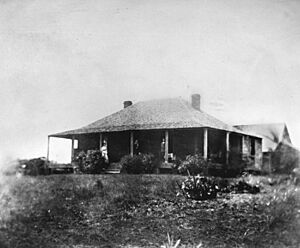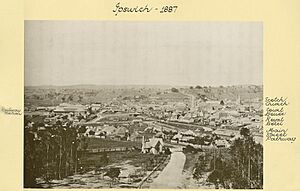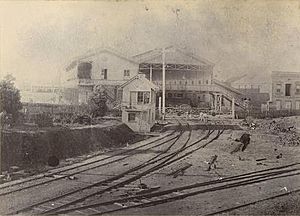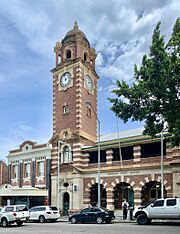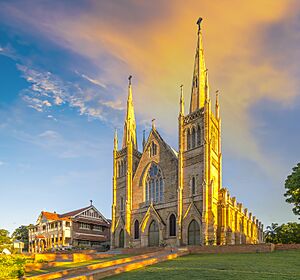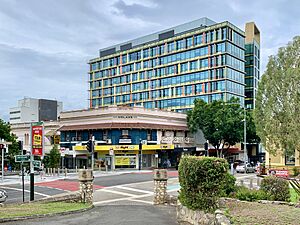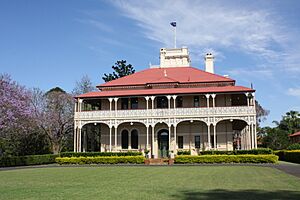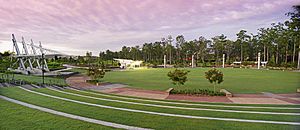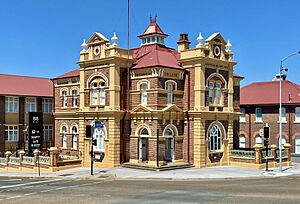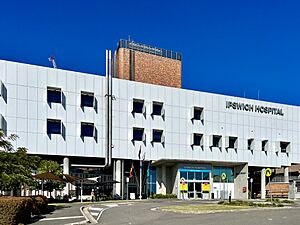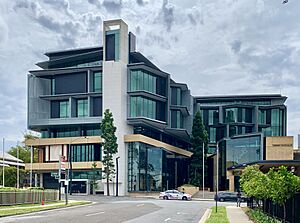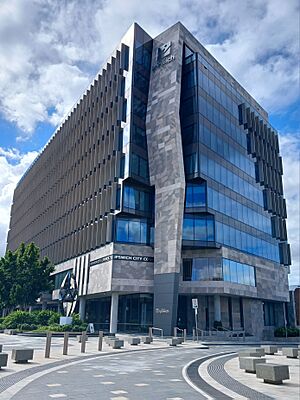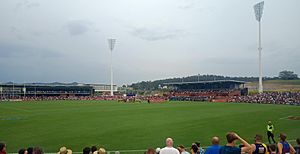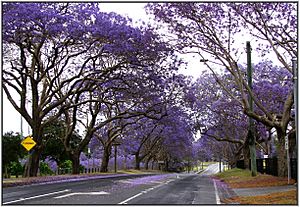Ipswich, Queensland facts for kids
Quick facts for kids IpswichQueensland |
|
|---|---|
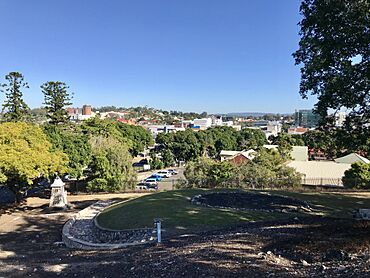
Ipswich from Cunninghams Knoll
|
|
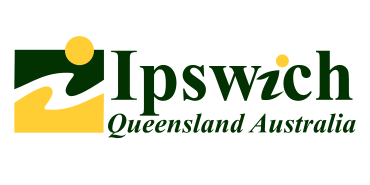
Flag of Ipswich (general use)
|
|
| Population | 115,913 (2021) |
| Established | 1827 |
| Postcode(s) | 4305 |
| Elevation | 50 m (164 ft) |
| Time zone | AEST (UTC+10:00) |
| Location | 42.7 km (27 mi) SW of Brisbane CBD |
| LGA(s) | City of Ipswich |
| Region | South East Queensland |
| State electorate(s) |
|
| Federal Division(s) | |
Ipswich is a lively city in South East Queensland, Australia. It sits on the Bremer River, about 40 kilometers (25 miles) west of Brisbane. Ipswich is famous for its beautiful old buildings, nature, and culture. The city takes pride in its history, with over 6,000 heritage-listed sites and more than 500 parks.
Ipswich started in 1827 as a place for mining. It quickly grew into a major center for business and people. The area called Ipswich is the city's main business district. In 2021, about 115,913 people lived in the Ipswich urban area.
Contents
History of Ipswich
How Ipswich Began
Before Europeans arrived, the Ipswich area was home to many Aboriginal groups. These included the Warpai, Yuggera, and Ugarapul people. They called the area Coodjirar in the Yugararpul language.
European explorers first came in 1826. Captain Patrick Logan explored the Brisbane River. He found large amounts of limestone and other minerals. This discovery was important for the area's future.
From Limestone to City
The town started in 1827 as a limestone mining settlement. It grew quickly as a major river port. At first, it was called "The Limestone Hills," then just "Limestone." In 1843, it was renamed "Ipswich" after a town in England.
By 1851, 932 people lived here. This number grew to 2,459 by 1856. Ipswich became a municipality in 1858. It was considered to be the capital of Queensland. However, Brisbane was chosen instead in 1859. Ipswich officially became a city in 1904.
Ipswich became a big coal mining area in the early 1800s. This led to the development of railways for transport. The first coal mines started in 1848. Cool fact: Triassic-aged dinosaur footprints were found in underground coal mines near Ebbw Vale!
From the 1840s, Ipswich was an important river port. It helped transport coal and wool from the Darling Downs. Steamboat services linked Ipswich and Brisbane. This was the main way to move goods until 1876. That's when the railway line between Ipswich and Brisbane was completed.
Ipswich was declared a municipality on March 3, 1860. It became a city in 1904. Many churches opened in Ipswich by 1873. These included Anglican, Roman Catholic, and Methodist churches.
Royal Family Visits
Several members of the British Royal Family have visited Ipswich over the years:
- 1868 – Prince Alfred, Duke of Edinburgh
- 1920 – Prince of Wales (later Edward VIII)
- 1927 – Duke and Duchess of York (later King George VI and Queen Elizabeth)
- 1958 – Queen Elizabeth The Queen Mother
- 1962 – Princess Alice, Countess of Athlone
- 2011 – Prince William
- 2014 – Duke and Duchess of Cambridge
Major Floods in Ipswich
Ipswich has experienced several damaging floods. The biggest was the 1893 Brisbane flood, which reached 24.5 meters. More recently, floods occurred in 1974 and 2011.
1893 Flood Impact
About 35 people died in the 1893 floods. The Brisbane River flooded three times in February that year. Seven workers died at a coal mine in North Ipswich.
1974 Flood Impact
Fourteen people died in the January 1974 floods. Two people were killed in Ipswich. About 1,800 homes and businesses in Ipswich were flooded.
2011 Flood Impact
The Bremer River in Ipswich reached 19.5 meters on January 12, 2011. This flooded the city center and thousands of homes. Sadly, 38 people died in these floods. A four-year-old boy was swept away in Minden. A man died in Wulkuraka after driving into floodwaters.
The areas of Goodna and Gailes were hit hardest. Bull sharks were even seen swimming in the streets of Goodna!
Community and Facilities
The Ipswich Central Library opened in 1994. The Ipswich Historical Society started in 1966. It is located at the Cooneana Heritage Centre. The Ipswich branch of the Queensland Country Women's Association meets at Liberty Hall.
Climate in Ipswich
Ipswich has a humid subtropical climate. This means it has hot, wet summers and mild, dry winters.
| Climate data for Ipswich-Amberley Air Base (27º37'48"S, 152º42'36"E, 24 m AMSL) (1991–2020 normals, extremes 1941–2024) | |||||||||||||
|---|---|---|---|---|---|---|---|---|---|---|---|---|---|
| Month | Jan | Feb | Mar | Apr | May | Jun | Jul | Aug | Sep | Oct | Nov | Dec | Year |
| Record high °C (°F) | 44.3 (111.7) |
43.0 (109.4) |
41.3 (106.3) |
36.8 (98.2) |
33.3 (91.9) |
29.9 (85.8) |
29.6 (85.3) |
36.4 (97.5) |
40.1 (104.2) |
41.3 (106.3) |
43.0 (109.4) |
43.8 (110.8) |
44.3 (111.7) |
| Mean daily maximum °C (°F) | 31.7 (89.1) |
30.9 (87.6) |
29.9 (85.8) |
27.6 (81.7) |
24.6 (76.3) |
22.1 (71.8) |
22.0 (71.6) |
23.8 (74.8) |
26.9 (80.4) |
28.5 (83.3) |
30.1 (86.2) |
31.0 (87.8) |
27.4 (81.4) |
| Mean daily minimum °C (°F) | 19.6 (67.3) |
19.4 (66.9) |
17.5 (63.5) |
13.4 (56.1) |
9.4 (48.9) |
6.8 (44.2) |
5.1 (41.2) |
5.4 (41.7) |
9.4 (48.9) |
13.0 (55.4) |
16.1 (61.0) |
18.2 (64.8) |
12.8 (55.0) |
| Record low °C (°F) | 11.6 (52.9) |
11.1 (52.0) |
6.7 (44.1) |
1.0 (33.8) |
−3.1 (26.4) |
−4.3 (24.3) |
−4.8 (23.4) |
−4.9 (23.2) |
−0.2 (31.6) |
2.1 (35.8) |
4.9 (40.8) |
6.8 (44.2) |
−4.9 (23.2) |
| Average precipitation mm (inches) | 108.1 (4.26) |
105.0 (4.13) |
77.7 (3.06) |
37.8 (1.49) |
54.0 (2.13) |
38.1 (1.50) |
23.4 (0.92) |
22.9 (0.90) |
31.5 (1.24) |
62.2 (2.45) |
81.8 (3.22) |
113.8 (4.48) |
750.3 (29.54) |
| Average precipitation days (≥ 1.0 mm) | 7.2 | 7.5 | 6.8 | 4.1 | 5.2 | 4.3 | 3.8 | 3.1 | 3.8 | 6.0 | 6.5 | 7.9 | 66.2 |
| Average afternoon relative humidity (%) | 49 | 53 | 49 | 45 | 45 | 45 | 39 | 34 | 35 | 40 | 45 | 48 | 44 |
| Average dew point °C (°F) | 17.6 (63.7) |
18.0 (64.4) |
15.9 (60.6) |
12.5 (54.5) |
9.7 (49.5) |
7.5 (45.5) |
5.0 (41.0) |
4.0 (39.2) |
6.5 (43.7) |
10.3 (50.5) |
13.5 (56.3) |
16.0 (60.8) |
11.4 (52.5) |
| Source: Bureau of Meteorology (1991–2020 normals, extremes 1941–2024) | |||||||||||||
People of Ipswich
In 2021, the population of the Ipswich urban area was 115,913 people.
Ipswich Economy
Ipswich was a major mining center, especially for coal mining. It's known as the "cradle of coal mining in Queensland." Other industries included pottery, sawmills, and metal foundries. The area also has rich farmland.

Today, manufacturing is still strong in Ipswich. Over 14% of workers are in this industry. This is much higher than the average for Queensland.
Ipswich and the Western Corridor region are expected to grow a lot. The economy is predicted to be worth $12.7 billion by 2026. Big companies like General Electric have moved their Queensland offices here.
Ipswich is also home to RAAF Base Amberley. This is the Royal Australian Air Force's largest base. It houses many important aircraft and support units.
Ipswich on Screen
Ipswich has become a popular place for filming movies and TV shows.
- The 2013 movie The Railway Man was filmed near the city's railyards.
- San Andreas, starring Dwayne Johnson, was also filmed here.
- Inspector Gadget 2 used locations around the city.
- Many Australian films and TV shows have been filmed in Ipswich.
Homes in Ipswich
Ipswich has many important historic buildings. You can see different styles of homes, from early colonial (1850s) to Queensland Bungalows (until 1935). Many historical places have markers and plaques.
Traditionally, Ipswich homes were detached houses with yards. This is changing as new housing developments grow. Ipswich is the fastest-growing area in South East Queensland.
Two big developments, Greater Springfield and Ripley Valley, are helping with this growth. Greater Springfield is a huge planned community. It's designed to have 85,000 people and is Australia's largest master-planned city. The Ripley Valley Development is planned for 120,000 people.
Ipswich Infrastructure
Technology and Innovation
In March 2016, Ipswich launched Fire Station 101. This is a hub for digital innovation and startups. It aims to make Ipswich a leader in the digital economy. In 2015, Ipswich was named one of the world's Top 7 most Intelligent Communities.
Education for All Ages
Ipswich has many primary and secondary schools. Ipswich Grammar School was Queensland's first high school, started in 1863. For higher education, there's the University of Southern Queensland and TAFE Queensland South West.
Keeping Ipswich Safe
Ipswich has a "Safe City" camera network. It started in 1994. Over 200 cameras are watched 24/7 from a special facility. Many law enforcement agencies from around the world have visited to learn about this system.
Getting Around Ipswich
Ipswich has great road access. The Ipswich Motorway connects to Brisbane. The Cunningham Highway goes to Warwick. The Warrego Highway leads to Toowoomba.
Ipswich railway station is a main hub for trains. The Ipswich railway line goes east to Brisbane. The Rosewood railway line goes west to Rosewood. Both lines are run by Queensland Rail.
Parks and Recreation
Ipswich has over 500 parks and conservation areas. One special park is Nerima Gardens. It was designed with help from Ipswich's Japanese sister city, Nerima. In 2015, Orion Lagoon opened in Springfield Central.
Brookwater has the Brookwater Golf and Country Club. This golf course was designed by Greg Norman. It has been voted Queensland's number one golf course.
The Ipswich Council has a public library and a separate children's library. These are part of the Nicolas Street Precinct upgrade in the city center.
Sports in Ipswich
Ipswich has seen many sporting successes. In 2022, the Brisbane Lions (an AFL team) moved their headquarters to Springfield Central Stadium. This stadium is now home to the club's women's team, the AFLW team. In 2015, the local rugby league team, Ipswich Jets, won their first Queensland Cup title.
- Football (Soccer): Western Pride plays in the National Premier League. Other teams include Ipswich Knights, Ipswich City Bulls, and Springfield United.
- Australian Rules Football: Springfield Central Stadium is the headquarters of the Brisbane Lions. Local teams include the Ipswich Eagles and Collingwood Park Power.
- Basketball: The Ipswich Force plays in the Queensland Basketball League. They play home games at Cotton On Foundation Stadium.
- Cricket: The Ipswich Logan Hornets play in the Brisbane Grade Cricket competition.
- Golf: The Ipswich City Golf Club is in Leichhardt, Queensland.
- Greyhound Racing: The Ipswich Showgrounds host greyhound racing.
- Gridiron: The Ipswich Cougars play in the Gridiron Queensland league.
- Hockey: Games are played at the Briggs Rd Sporting Complex.
- Motorsport: Drag racing happens at Willowbank Raceway. V8 Supercars race at Queensland Raceway each year.
- Rugby League: The Ipswich Jets play in the Queensland Cup. Ipswich also has a local league with many junior and senior teams.
- Rugby Union: The Ipswich Rangers play in the Queensland Suburban Rugby Union competition.
- Softball: The Ipswich Softball Association has teams for all ages, from Tee Ball to A Grade.
Exciting Events in Ipswich
Ipswich Show
The first Ipswich Annual Show was held on April 2, 1873. It moved to its current home at the Ipswich Showgrounds in 1877. It's a fun event for the whole family!
Goodna Jacaranda Festival
This festival has been held every year in Goodna since 1968. It celebrates the beautiful purple Jacaranda trees.
Ipswich Festival
The Ipswich Festival is an annual event with many different activities. It started in 1998. The festival includes live bands, concerts, art, fireworks, and family events. Most events are free and happen over two weeks in late April and early May.
Winternationals
The Fuchs Winternationals is a big annual drag racing event. It usually happens in June at Willowbank Raceway. This four-day event is one of the largest drag racing festivals in the Southern Hemisphere. It attracts huge crowds!
Famous People from Ipswich
Sports Stars
- Deborah Acason: Weightlifter, won gold at the 2006 Commonwealth Games.
- Ashleigh Barty: Professional tennis player and cricketer, former world No. 1.
- John Buchanan: Former coach of the Australian cricket team.
- Israel Folau: Famous triple-code footballer (rugby league, rugby union, Australian rules football).
- Allan Langer: Rugby league legend.
- Craig McDermott: Represented Australia in cricket.
- Mark Tonelli: Olympic gold medalist in swimming.
- The "Walters Brothers": Kevin Walters, Kerrod Walters, and Steve Walters, all famous rugby league players.
- Shane Watson: Represented Australia in cricket.
Entertainment and Arts
- Tony Barry: Actor.
- John Birmingham: Author.
- D'Arcy Doyle: Painter.
- George Miller: Hollywood director (known for Mad Max).
- Thomas Shapcott: Author and poet.
See also
 In Spanish: Ipswich (Australia) para niños
In Spanish: Ipswich (Australia) para niños



